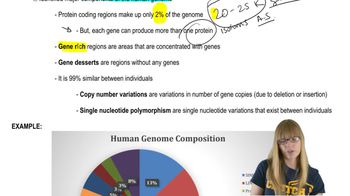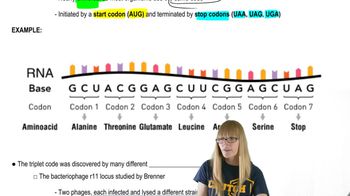Here are the essential concepts you must grasp in order to answer the question correctly.
Amino Acid Composition
Amino acids are the building blocks of proteins, and their composition can influence protein structure and function. Leucine, histidine, and tryptophan are essential amino acids, each with distinct roles in protein synthesis. Understanding the relative abundance of these amino acids in proteins can provide insights into their biological significance and the evolutionary pressures that shape protein sequences.
Recommended video:
Codon Usage
Codons are sequences of three nucleotides in mRNA that correspond to specific amino acids during protein synthesis. The number of codons available for each amino acid affects its frequency in proteins. Leucine has six codons, histidine has two, and tryptophan has one, which explains why leucine is often more abundant than histidine, and histidine is more common than tryptophan in proteins.
Recommended video:
Genetic Code and Redundancy
The genetic code is degenerate, meaning that multiple codons can encode the same amino acid. This redundancy allows for variations in codon usage among different organisms and can influence the frequency of amino acids in proteins. The higher number of codons for leucine compared to histidine and tryptophan suggests that leucine is more readily incorporated into proteins, reflecting its greater availability in the genetic code.
Recommended video:





